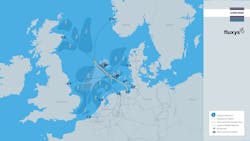Gascade and Fluxys Ramp Up Green Hydrogen Pipeline Plans
Two European transmission system operators say they’re a step closer to building a 400-kilometer (248-mile) pipeline in the North Sea that would connect to an offshore wind farm to produce green hydrogen.
Gascade and Fluxys have applied to the European Commission for Project of Common Interest (PCI) status for the AquaDuctus project, the companies said Jan. 23.
PCIs are key cross-border infrastructure projects that link the energy systems of EU countries and are intended to help the EU achieve its energy policy and climate objectives, according to the European Commission website.
The pipeline will serve as a “backbone” for multiple production sites, with the potential to link to other international hydrogen flows through the North Sea. When completed, the pipeline will move hydrogen to the German coast and feed an onshore hydrogen network there, the companies said.
The first step in the project will involve connecting the SEN-1 hydrogen wind farm connected to AquaDuctus, with flows to start in 2030. Future plans include the possibility of linking wind farms further offshore with hydrogen pipelines operated by other North Sea countries.
By 2035, the plan for the partners expect to develop a main hydrogen corridor carrying up to 1 million metric tons of hydrogen a year into Germany. Based on the gas and hydrogen package currently being negotiated at European level, the two long-standing transmission system operators plan the AquaDuctus offshore pipeline as a regulated open-access infrastructure available to all future operators of hydrogen wind farms, thereby strengthening security of supply in the future, the companies said."We firmly believe that the AquaDuctus offshore pipeline will be a key element of Europe's future energy supply picture and a major advance in the drive towards climate neutrality," says Fluxys Managing Director and CEO Pascal De Buck.
A comprehensive feasibility study for the project has been successfully completed. The study examined and confirmed the technical and planning feasibility of all phases of the project. The companies have also analyzed commercial aspects, marketing potential, pricing and regulatory design options of the project.
